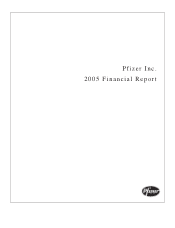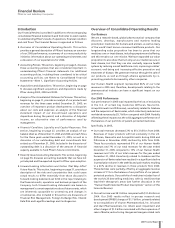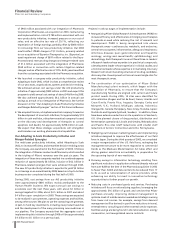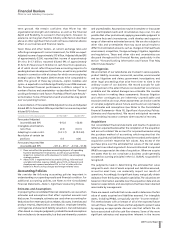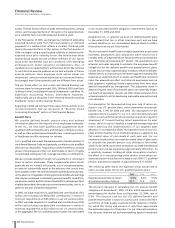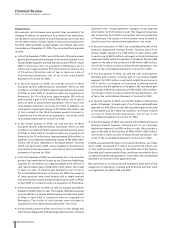Pfizer 2005 Annual Report Download - page 9
Download and view the complete annual report
Please find page 9 of the 2005 Pfizer annual report below. You can navigate through the pages in the report by either clicking on the pages listed below, or by using the keyword search tool below to find specific information within the annual report.
82005 Financial Report
Financial Review
Pfizer Inc and Subsidiary Companies
events. The key factors influencing the estimation process, among
others, are the expected term of the option, the expected stock
price volatility factor and the expected dividend yield.
In the first quarter of 2005, we changed our method of estimating
expected dividend yield from historical patterns of dividend
payments to a method that reflects a constant dividend yield
during the expected term of the option. In the first quarter of
2004, we began using quoted implied volatility to determine the
expected stock price volatility factor. We believe that these
market-based inputs provide a better estimate of our future
stock price movements and are consistent with emerging
employee stock option valuation considerations. Also, of
significance, is our expected term until exercise factor. We continue
to use historical exercise patterns as our best estimate of future
exercise patterns. Once employee stock option values are
determined, current accounting practices do not permit them to
be changed, even if the estimates used are different from actual.
The pro forma effect on net income and diluted earnings per
common share for the years ended 2005, 2004 and 2003 is set forth
in Notes to the Consolidated Financial Statements—see Note 1P,
Significant Accounting Policies: Share-Based Payments.
Additionally, see our discussion in the “Recently Issued Accounting
Standards” section of this Financial Review.
Beginning in 2006, we will report the value of stock options in our
income statement. See our discussion in “Recently Issued
Accounting Standards” section of this Financial Review.
Benefit Plans
We provide defined benefit pension plans and defined
contribution plans for the majority of our employees worldwide.
In the U.S., we have both qualified and supplemental (non-
qualified) defined benefit plans and defined contribution plans,
as well as other postretirement benefit plans, consisting primarily
of healthcare and life insurance for retirees.
A U.S. qualified plan meets the requirements of certain sections of
the Internal Revenue Code and, generally, contributions to qualified
plans are tax deductible. It typically provides benefits to a broad
group of employees and may not discriminate in favor of highly
compensated employees in its coverage, benefits or contributions.
We also provide benefits through non-qualified U.S. retirement
plans to certain employees. These supplemental plans, which
generally are not funded, will provide, out of our general assets,
an amount substantially equal to the amounts that would have
been payable under the defined benefit qualified pension plans,
in the absence of legislation limiting pension benefits and earnings
that may be considered in calculating pension benefits. In addition,
we provide medical and life insurance benefits to retirees and their
eligible dependents through our postretirement plans, which, in
general, are also unfunded obligations.
In 2005, we made required U.S. qualified plan contributions of $3
million and voluntary tax-deductible contributions in excess of
minimum requirements of $49 million to our U.S. pension plans.
In 2004, we made required U.S. qualified plan contributions of $29
million and voluntary tax-deductible contributions in excess of
minimum requirements of $52 million to our U.S. pension plans.
In the aggregate, the U.S. qualified pension plans are overfunded
on an accumulated benefit obligation measurement basis as of
December 31, 2005 and 2004.
Outside the U.S., in general, we fund our defined benefit plans
to the extent that tax or other incentives exist and we have
accrued liabilities on our consolidated balance sheets to reflect
those plans that are not fully funded.
The accounting for benefit plans is highly dependent on actuarial
estimates, assumptions and calculations which result from a
complex series of judgments about future events and uncertainties
(see “Estimates and Assumptions” above). The assumptions and
actuarial estimates required to estimate the employee benefit
obligations for the defined benefit and postretirement plans,
include discount rate; expected salary increases; certain employee-
related factors, such as turnover, retirement age and mortality (life
expectancy); expected return on assets; and healthcare cost trend
rates. Our assumptions reflect our historical experiences and our
best judgment regarding future expectations that have been
deemed reasonable by management. The judgments made in
determining the costs of our benefit plans can materially impact
our results of operations. As such, we often obtain assistance from
actuarial experts to aid in developing reasonable assumptions and
cost estimates.
Our assumption for the expected long-term rate of return-on-
assets in our U.S. pension plans, which determines net periodic
benefit cost, is 9% for 2006 and 2005. The assumption for the
expected return-on-assets for our U.S. and international plans
reflects our actual historical return experience and our long-term
assessment of forward-looking return expectations by asset
classes, which is used to develop a weighted-average expected
return based on the implementation of our targeted asset
allocation in our respective plans. The expected return for our U.S.
plans and the majority of our international plans is applied to the
fair market value of plan assets at each year end. For our
international plans that use a market-related value of plan assets
to calculate net periodic pension cost, shifting to fair market
value of plan assets would serve to decrease our 2006 international
pension plans’ pre-tax expense by approximately $29 million. As
a sensitivity measure, holding all other assumptions constant,
the effect of a one-percentage-point decline in the return-on-
assets assumption would be an increase in our 2006 U.S. qualified
pension plan pre-tax expense of approximately $71 million.
The following table shows the expected versus actual rate of
return on plan assets for the U.S. qualified pension plans:
2005 2004 2003
Expected annual rate of return 9.0% 9.0% 9.0%
Actual annual rate of return 10.1 11.5 21.4
The discount rate used in calculating our U.S. pension benefit
obligations at December 31, 2005, is 5.8%, which represents a 0.2
percentage-point decline from our December 31, 2004, rate of
6.0%. The discount rate for our U.S. defined benefit and
postretirement plans is based on a yield curve constructed from
a portfolio of high quality corporate bonds rated AA or better
for which the timing and amount of cash flows approximate
the estimated payouts of the plans. For our international plans,
the discount rates are set by benchmarking against investment

